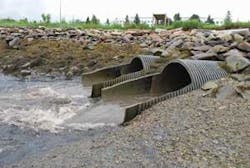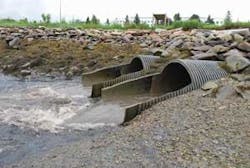Will the Water Framework Directive be a Washout?
By Mike Faram and Robert Andoh
European stormwater regulations should take a holistic approach to stormwater treatment.
The EU Water Framework Directive (WFD) is being implemented across Europe, signaling a change of thinking in the way water issues are addressed. The directive commits member states to achieving good ecological status of all water bodies by the year 2015. While it offers a certain amount of flexibility to each member state, the document attempts to take a unified approach around the concept of water as a precious natural commodity that must be preserved and regulated to a higher standard.
The emphasis on water quality brings into focus an issue long discussed in Europe but not yet put into practice on a grand scale – a more aggressive treatment of sediment associated pollutants in stormwater flows. A lot of energy has been devoted to flow control, to preserve the relatively densely developed areas from flood damage. But resources to address pollution caused by stormwater runoff from man-made surfaces has been given a lower priority.
This will likely change. Runoff tends to carry a high sediment load, and this – along with sediment associated pollutants – can have a detrimental impact on receiving watercourses. Research has highlighted the role of sediment in pollutant transport and dispersion. Sediment particles can absorb some chemical pollutants such as phosphates and pesticides, and also tend to be associated with other pollutants including heavy metals and hydrocarbons. As such, sediment entrained in urban run-off should ideally be prevented from entering watercourses.
Washout vs. Retention
Throughout the world, thousands of stormwater pollutant removal systems are being installed in an effort to prevent watercourses from being contaminated. As supply has risen to meet demand, a variety of proprietary, chamber-based systems have emerged, including hydrodynamic separators, which are designed to settle out and store sediments and associated pollutants, preventing them from being discharged to the natural environment.
While these treatment devices tend to be effective at removing pollutants under low-flow runoff conditions, they don’t always hold what they catch. When runoff flows reach moderate or high levels, turbulence of the flow has been shown to re-suspend and discharge previously captured pollutants from poorly designed stormwater treatment chambers and separators; carrying the re-suspended pollutants downstream. This phenomenon is known as “washout.”
A device effective at removing pollutants under low-flow conditions but prone to re-suspending and washing out of previously captured materials when flows increase does not serve its function and provides very little environmental benefit overall. Stormwater treatment devices are typically maintained on an infrequent basis, thus they must be able to retain and store pollutants through several rainy seasons for later removal during maintenance visits. Installing poorly designed treatment systems provides a false sense of security to those relying on them to keep their water clean.
U.S. vs. EU Standards
With the prospect in Europe that stormwater treatment regulations will soon be enacted, reflecting requirements of the WFD, there’s evidence some U.S. manufacturers of poorly designed hydrodynamic stormwater treatment devices are now seeking opportunities in European markets.
U.S. standards of proprietary treatment chambers have tended to focus on performance in terms of pollutant removal efficiency under conditions up to their “design” or “treatment” flow rates. But the question of overall performance, including ability to retain previously captured material when operated within and beyond their design flow ranges, has generally been neglected.
Though removal efficiency is a good indicator of a device’s effectiveness in separating pollutants from stormwater, particularly under low-flow conditions, it doesn’t provide a complete description of device efficacy, especially in terms of its ability to retain previously captured pollutants during moderately intense storms exceeding “design” flow.
Gully Pots & Drainage Pipes
Until recently, simple gully pots were used as entry points to storm drainage systems; to remove debris from stormwater thereby preventing clogging in the drainage pipes. A recent study by the Centre for Environmental Technology (LCET) at Liverpool’s John Moore University, however, revealed that gully pots actually represent a source of pollution due to ineffective pollution retention.
Hydro International provided supervisory/advisory inputs, and facilities for the LCET study. The researchers also examined interrelationships between a treatment system’s chamber design and pollutant washout. Their goal was to determine sediment retention performance of different stormwater treatment chamber configurations under controlled laboratory conditions.
For this study, a sediment stimulant was allowed to settle in the chamber base, corresponding to the region where it would be stored in practice. Next, adding dye to color the initial water contained, provided researchers a visualization of the fate of the soluble pollutants. Lastly, flow was passed through the chamber of each device, and particles that were re-suspended and washed out of the system were collected at the outlet.
The study confirmed pollutant washout is a very real problem and must be taken into account in treatment system selection. It also was concluded the rate of washout varied greatly depending on type of chamber design, with re-suspension or re-entrainment rates ranging from near zero up to 100% depending on device configuration, nature and type of flow modifying components, and whether or not sediments are stored in isolated storage zones.
The study also determined:
- In the worst cases, washout commences almost immediately at flows likely to be encountered even in the early stages of a storm event
- The best performing chambers were found to have induced rotary flows and flow modifying internal components that hydraulically separated sediment storage volume from the active treatment zone.
Conclusion
Although proprietary treatment devices have been installed in the United States since the
National Pollutant Discharge Elimination System (NPDES) Phase I program began in 1990, they’re only just beginning to require that hydrodynamic systems be selected using retention performance as a design requirement.
While European nations are in the process of implementing the WFD, it’s critical the propensity for washout be given the highest priority, and that systems are assessed and tested with this objective in mind. Removing sediments from stormwater falls short of the WFD’s objectives unless they’re also retained.
Authors’ Notes:
Michael Faram, Ph.D., is group technical manager at Hydro International. Robert Y.G. Andoh is the company’s director of innovation as well as a visiting professor at Liverpool’s John Moores University. Based in Portland, Maine, USA, with offices in the UK and Ireland, the company provides cost effective solutions for controlling the quantity and improving the quality of water and wastewater with a special emphasis on stormwater coverage for the construction industry and enhanced treatment solutions in the municipal sector. Contact: +44 (0) 1275 878371, [email protected] or www.hydro-international.biz


